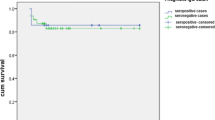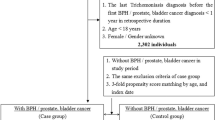Abstract
Purpose
Results from previous sero-epidemiologic studies of Trichomonas vaginalis infection and prostate cancer (PCa) support a positive association between this sexually transmitted infection and aggressive PCa. However, findings from previous studies are not entirely consistent, and only one has investigated the possible relation between T. vaginalis seropositivity and PCa in African-American men who are at highest risk of both infection and PCa. Therefore, we examined this possible relation in the Prostate, Lung, Colorectal, and Ovarian Cancer Screening Trial, including separate analyses for aggressive PCa and African-American men.
Methods
We included a sample of participants from a previous nested case–control study of PCa, as well as all additional Caucasian, aggressive, and African-American cases diagnosed since the previous study (total n = 438 Gleason 7 Caucasian cases, 487 more advanced Caucasian cases (≥Gleason 8 or stage III/IV), 201 African-American cases, and 1216 controls). We tested baseline sera for T. vaginalis antibodies.
Results
No associations were observed for risk of Gleason 7 (odds ratio (OR) = 0.87, 95% confidence interval (CI) 0.55–1.37) or more advanced (OR = 0.90, 95% CI 0.58–1.38) PCa in Caucasian men, or for risk of any PCa (OR = 1.06, 95% CI 0.67–1.68) in African-American men.
Conclusions
Our findings do not support an association between T. vaginalis infection and PCa.
Similar content being viewed by others
References
De Marzo AM et al (2007) Inflammation in prostate carcinogenesis. Nat Rev Cancer 7(4):256–269
Holmes KK et al (eds) (2008) Sexually transmitted diseases, 4th edn. McGraw-Hill, New York
Sutcliffe S (2010) Sexually transmitted infections and risk of prostate cancer: review of historical and emerging hypotheses. Future Oncol 6(8):1289–1311
Twu O et al (2014) Trichomonas vaginalis homolog of macrophage migration inhibitory factor induces prostate cell growth, invasiveness, and inflammatory responses. Proc Natl Acad Sci USA 111(22):8179–8184
Zhu Z et al (2016) Trichomonas vaginalis: a possible foe to prostate cancer. Med Oncol 33(10):115
Han IH et al (2016) Signalling pathways associated with IL-6 production and epithelial-mesenchymal transition induction in prostate epithelial cells stimulated with Trichomonas vaginalis. Parasite Immunol 38(11):678–687
Sutcliffe S et al (2012) Trichomonosis, a common curable STI, and prostate carcinogenesis–a proposed molecular mechanism. PLoS Pathog 8(8):e1002801
Sutcliffe S et al (2006) Plasma antibodies against Trichomonas vaginalis and subsequent risk of prostate cancer. Cancer Epidemiol Biomarkers Prev 15(5):939–945
Sutcliffe S et al (2009) Trichomonosis and subsequent risk of prostate cancer in the prostate cancer prevention trial. Int J Cancer 124(9):2082–2087
Stark JR et al (2009) Prospective study of Trichomonas vaginalis infection and prostate cancer incidence and mortality: Physicians’ Health Study. J Natl Cancer Inst 101(20):1406–1411
Shui IM et al (2016) Trichomonas vaginalis infection and risk of advanced prostate cancer. Prostate 76(7):620–623
Fowke JH et al (2016) A prospective study of Trichomonas vaginalis and prostate cancer risk among African American men. BMC Res Notes 9(1):224
Miller WC et al (2005) The prevalence of trichomoniasis in young adults in the United States. Sex Transm Dis 32(10):593–598
Siegel RL, Miller KD, Jemal A (2015) Cancer statistics, 2015. CA Cancer J Clin 65(1):5–29
Huang WY et al (2008) Sexually transmissible infections and prostate cancer risk. Cancer Epidemiol Biomarkers Prev 17(9):2374–2381
Prorok PC et al (2000) Design of the Prostate, Lung, Colorectal and Ovarian (PLCO) Cancer Screening Trial. Control Clin Trials 21(6 Suppl):273S–309S
Andriole GL et al (2005) Prostate cancer screening in the Prostate, Lung, Colorectal and Ovarian (PLCO) Cancer Screening Trial: findings from the initial screening round of a randomized trial. J Natl Cancer Inst 97(6):433–438
Alderete JF (1984) Enzyme linked immunosorbent assay for detecting antibody to Trichomonas vaginalis: use of whole cells and aqueous extract as antigen. Br J Vener Dis 60(3):164–170
Neace CJ, Alderete JF (2013) Epitopes of the highly immunogenic Trichomonas vaginalis alpha-actinin are serodiagnostic targets for both women and men. J Clin Microbiol 51(8):2483–2490
Alderete JF, Neace CJ (2013) Identification, characterization, and synthesis of peptide epitopes and a recombinant six-epitope protein for Trichomonas vaginalis serodiagnosis. ImmunoTargets Ther 2:91–103
Sutcliffe S et al (2015) Persistence of Trichomonas vaginalis serostatus in men over time. Cancer Causes Control 26(10):1461–1466
Lunn M, McNeil D (1995) Applying cox regression to competing risks. Biometrics 51(2):524–532
Sutcliffe S et al (2015) Prospective study of human herpesvirus type 8 serostatus and prostate cancer risk in the placebo arm of the Prostate Cancer Prevention Trial. Cancer Causes Control 26(1):35–44
Cannon MJ, Schmid DS, Hyde TB (2010) Review of cytomegalovirus seroprevalence and demographic characteristics associated with infection. Rev Med Virol 20(4):202–213
Korodi Z et al (2005) No serological evidence of association between prostate cancer and infection with herpes simplex virus type 2 or human herpesvirus type 8: a nested case–control study. J Infect Dis 191(12):2008–2011
Dennis LK et al (2009) Sexually transmitted infections and prostate cancer among men in the U.S. military. Cancer Epidemiol Biomarkers Prev 18(10):2665–2671
Chung SD et al (2013) Increased risk of prostate cancer following sexually transmitted infection in an Asian population. Epidemiol Infect 141(12):2663–2670
Caini S et al (2014) Sexually transmitted infections and prostate cancer risk: a systematic review and meta-analysis. Cancer Epidemiol 38(4):329–338
Vazquez-Salas RA et al (2016) History of gonorrhea and prostate cancer in a population-based case–control study in Mexico. Cancer Epidemiol 40:95–101
Cheng I et al (2010) Prostatitis, sexually transmitted diseases, and prostate cancer: the California men’s health study. PLoS ONE 5(1):e8736
Acknowledgments
The authors thank the National Cancer Institute (NCI) for providing the human material collected by PLCO; Karen Pettit, Sally Larson, and Amy Hutchinson for performing or coordinating serum specimen retrieval and aliquoting; Mike Furr, Craig Williams, and Ryan Noble for managing study data; Calvin Neace and Patrick A. Joyce for performing T. vaginalis antibody testing; Drs. Raphael P. Viscidi, Francis K. Lee, Yun F. Wang, and Denise Whitby and their staff for performing or supervising STI testing in the previous nested case–control study in PLCO; and Dr. Graham A. Colditz for helpful review of our NCI Grant. PLCO is supported by the Intramural Research Program of the Division of Cancer Epidemiology and Genetics, and by contracts from the Division of Cancer Prevention, NCI, National Institutes of Health, the Department of Health and Human Services. This study was funded by NCI Grant R03 CA143949; the Intramural Research Program of the Division of Cancer Epidemiology and Genetics, NCI, the National Institutes of Health, the Department of Health and Human Services; the Barnes-Jewish Hospital Foundation; and the Alvin J. Siteman Cancer Center.
Author information
Authors and Affiliations
Corresponding author
Electronic supplementary material
Below is the link to the electronic supplementary material.
Rights and permissions
About this article
Cite this article
Marous, M., Huang, WY., Rabkin, C.S. et al. Trichomonas vaginalis infection and risk of prostate cancer: associations by disease aggressiveness and race/ethnicity in the PLCO Trial. Cancer Causes Control 28, 889–898 (2017). https://doi.org/10.1007/s10552-017-0919-6
Received:
Accepted:
Published:
Issue Date:
DOI: https://doi.org/10.1007/s10552-017-0919-6




